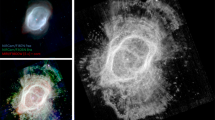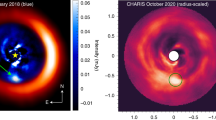Abstract
The Sun and >15 per cent of nearby stars are surrounded by dusty disks that must be collisionally replenished by asteroids and comets, as the dust would otherwise be depleted on timescales <107 years (ref. 1). Theoretical studies show that the structure of a dusty disk can be modified by the gravitational influence of planets2,3,4, but the observational evidence is incomplete, at least in part because maps of the thermal infrared emission from the disks have low linear resolution (35 au in the best case5). Optical images provide higher resolution, but the closest examples (AU Mic and β Pic) are edge-on6,7, preventing the direct measurement of the azimuthal and radial disk structure that is required for fitting theoretical models of planetary perturbations. Here we report the detection of optical light reflected from the dust grains orbiting Fomalhaut (HD 216956). The system is inclined 24° away from edge-on, enabling the measurement of disk structure around its entire circumference, at a linear resolution of 0.5 au. The dust is distributed in a belt 25 au wide, with a very sharp inner edge at a radial distance of 133 au, and we measure an offset of 15 au between the belt's geometric centre and Fomalhaut. Taken together, the sharp inner edge and offset demonstrate the presence of planetary-mass objects orbiting Fomalhaut.
This is a preview of subscription content, access via your institution
Access options
Subscribe to this journal
Receive 51 print issues and online access
$199.00 per year
only $3.90 per issue
Buy this article
- Purchase on Springer Link
- Instant access to full article PDF
Prices may be subject to local taxes which are calculated during checkout



Similar content being viewed by others
References
Backman, D. E. & Paresce, F. in Protostars and Protoplanets III (eds Levy, E. H. & Lunine, J. I.) 1253–1304 (Univ. Arizona Press, Tucson, 1993)
Roques, F., Scholl, H., Sicardy, B. & Smith, B. A. Is there a planet around beta Pictoris? Perturbations of a planet on a circumstellar dust disk. 1: The numerical model. Icarus 108, 37–58 (1994)
Liou, J.-C. & Zook, H. A. Signatures of giant planets imprinted on the Edgeworth-Kuiper Belt dust disk. Astron. J. 118, 580–590 (1999)
Ozernoy, L. M., Gorkavyi, N. N., Mather, J. C. & Taidakova, T. A. Signatures of extrasolar planets on dust debris disks. Astrophys. J. 537, L147–L151 (2000)
Greaves, W. S. et al. Structure in the epsilon Eridani debris disk. Astrophys. J. 619, L187–L190 (2005)
Smith, B. A. & Terrile, R. J. A circumstellar disk around Beta Pictoris. Science 226, 1421–1424 (1984)
Kalas, P., Liu, M. C. & Matthews, B. C. Discovery of a large dust disk around the nearby star AU Microscopii. Science 303, 1990–1993 (2004)
Aumann, H. H. IRAS observations of matter around nearby stars. Publ. Astron. Soc. Pacif. 97, 885–891 (1985)
Gillett, F. in Light on Dark Matter (ed. Israel, F. P.) 61–69 (Reidel, Dordrecht, 1986)
Holland, W. S. et al. Submillimeter images of dusty debris around nearby stars. Nature 392, 788–791 (1998)
Dent, W. R. F., Walker, H. J., Holland, W. S. & Greaves, J. S. Models of the dust structures around Vega-excess stars. Mon. Not. R. Astron. Soc. 314, 702–712 (2000)
Smart, W. M. On the derivation of the elements of a visual binary orbit by Kowalsky's method. Mon. Not. R. Astron. Soc. 90, 534–538 (1930)
Kalas, P. & Jewitt, D. The detectability of Beta Pic-like circumstellar disks around nearby main sequence stars. Astron. J. 111, 1347–1355 (1996)
Clampin, M. et al. Hubble Space Telescope ACS coronagraphic imaging of the circumstellar disk around HD 141569. Astrophys. J. 126, 358–392 (2003)
Fixsen, D. J. & Dwek, E. The zodiacal emission spectrum as determined by COBE and its implications. Astrophys. J. 578, 1009–1014 (2002)
Stapelfeldt, K. R. et al. First look at the Fomalhaut debris disk with the Spitzer Space Telescope. Astrophys. J. Suppl. 154, 439–442 (2004)
Artymowicz, P. & Clampin, M. Dust around main-sequence stars: Nature or nurture by the interstellar medium? Astron. J. 490, 863–878 (1997)
Wyatt, M. C. & Dent, W. R. F. Collisional processes in extrasolar planetesimal discs — dust clumps in Fomalhaut's debris disc. Mon. Not. R. Astron. Soc. 334, 589–607 (2002)
Holland, W. S. et al. Submillimeter observations of an asymmetric dust disk around Fomalhaut. Astrophys. J. 582, 1141–1146 (2003)
Chiang, E. I. & Goldreich, P. Apse alignment of narrow eccentric planetary rings. Astrophys. J. 540, 1084–1090 (2000)
Wyatt, M. C. et al. How observations of circumstellar disk asymmetries can reveal hidden planets: Pericenter glow and its application to the HR 4796 disk. Astrophys. J. 527, 918–944 (1999)
Kuchner, M. J. & Holman, M. J. The geometry of resonant signatures in debris disks with planets. Astrophys. J. 588, 1110–1120 (2003)
Moro-Martin, A. & Malhotra, R. A study of the dynamics of dust from the Kuiper Belt: Spatial distribution and spectral energy distribution. Astron. J. 124, 2305–2321 (2002)
Barrado y Navascues, D. The Castor moving group. The age of Fomalhaut and Vega. Astron. Astrophys. 339, 831–839 (1998)
Kalas, P. & Jewitt, D. Asymmetries in the Beta Pictoris dust disk. Astron. J. 110, 1008–1017 (1995)
Krist, J. et al. Hubble Space Telescope ACS coronagraphic imaging of the AU Microscopii debris disk. Astron. J. 129, 1008–1017 (2005)
Luu, J. X. & Jewitt, D. Kuiper Belt Objects: Relics from the accretion disk of the Sun. Annu. Rev. Astron. Astrophys. 40, 63–101 (2002)
Kelsall, T. et al. The COBE diffuse infrared background experiment search for the cosmic infrared background. II. Model of the interplanetary dust cloud. Astrophys. J. 508, 44–73 (1998)
Acknowledgements
This research is based on observations with the NASA/ESA Hubble Space Telescope, which is operated by the Association of Universities for Research in Astronomy. P.K. acknowledges support from the Space Telescope Science Institute and NASA's Origins of Solar Systems programme. P.K. and J.R.G. also thank the NSF Center for Adaptive Optics, managed by the University of California, Santa Cruz.
Author information
Authors and Affiliations
Corresponding author
Ethics declarations
Competing interests
Reprints and permissions information is available at npg.nature.com/reprintsandpermissions. The authors declare no competing financial interests.
Rights and permissions
About this article
Cite this article
Kalas, P., Graham, J. & Clampin, M. A planetary system as the origin of structure in Fomalhaut's dust belt. Nature 435, 1067–1070 (2005). https://doi.org/10.1038/nature03601
Received:
Accepted:
Issue Date:
DOI: https://doi.org/10.1038/nature03601
This article is cited by
-
Spatially resolved imaging of the inner Fomalhaut disk using JWST/MIRI
Nature Astronomy (2023)
-
Astrophotonics: astronomy and modern optics
The Astronomy and Astrophysics Review (2021)
-
Spitzer’s debris disk legacy from main-sequence stars to white dwarfs
Nature Astronomy (2020)
-
Five steps in the evolution from protoplanetary to debris disk
Astrophysics and Space Science (2015)
-
Proposed exoplanets may be just gas and dust
Nature (2013)
Comments
By submitting a comment you agree to abide by our Terms and Community Guidelines. If you find something abusive or that does not comply with our terms or guidelines please flag it as inappropriate.



